
SRAM has just released its latest version of its top-end gravel groupset, SRAM RED XPLR. This group is unquestionably the biggest shift in the SRAM gravel realm since its inception, in that it moves from what has effectively been a tweaked road-bike rear derailleur, to something very similar to a SRAM Transmission mountain bike rear derailleur. Plus, the era of 13-speed cassettes has arrived.
Beyond that, the complete setup also pairs with SRAM’s new Zipp 303 XPLR wheelset and a new XPLR tire partnership with Goodyear. All of which is designed to be the most performance-oriented gravel bike setup out there. Oh, and there’s an updated power meter as well. And some bonus buttons too.
I’ve been riding it for the past month on a loaner Specialized Crux (new model with UDH), across all sorts of terrain conditions, including a multi-day adventure in the mountains. If you found this review useful, you can use the links at the bottom, or consider becoming a DCR Supporter, which makes the site ad-free, while also getting access to a video series behind the scenes of the DCR Cave. And of course, it makes you awesome.
The Geeky Specs:

This section is all about specs. Mostly, numbers. Lots and lots of numbers. In short, the two numbers people pretend to care about the most are weight and price. Essentially, this new RED XPLR groupset drops the weight from 2,575g to 2,488g (with power meter) compared to the previous RED XPLR eTAP AXS groupset. The SRAM Force XPLR AXS groupset is 2,715g.
Meanwhile, pricing remains in the unobtanium level, with a complete power-meter-laden groupset coming in at $3,979 (or $3,529 without power meter). Of course, the overwhelming majority of people are actually buying this groupset on a new bike, in which case the cost is simply bundled in, and the true cost to the consumer is but a fraction of those values.
And while normally we might see more people buying groupsets like this aftermarket to add on existing bikes, that’s less likely here. That’s because this requires a UDH-compatible *gravel* frame, and there’s very few of those on the market today (compared to plenty on MTB, but this isn’t compatible with MTB due to interoperability breakpoints with suspension and not being flat-bar).
In any case, we’re getting distracted from silly quantities of numbers. Thus, here’s the complete weights table first:

Then the complete pricing table:

And finally, for all those geeks in the crowd, the good stuff: SRAM’s complete technical product presentations. They are historically fan favorites here, so I continue to publish them. SRAM unquestionably leads the sports tech world in terms of providing media with oodles of technical details ahead of launch, and these product presentations are some of the best sources of technical goodness. First, here’s the RED XPLR one:
And then, here’s the Zipp 303 XPLR one:
Now, go forth and enjoy some light reading. With that, let’s start using it.
The Components:

The first thing to understand is that true to the spirit of gravel bikes, the RED XPLR groupset is a bit of a mash-mash of existing things, albeit with some new bits as well. Essentially, the entire front-end of the bike is literally just the recently released SRAM RED road groupset. That includes the controls (shifters/levers), the calipers, the chain, and the XDR drive body in the back.

That’s of course not a bad thing. The new shifters have been well received, including both the increased one-finger braking performance as well as the new bonus button.

Sliding our way down the bike, we’ve got the front chainring, in a 1x configuration as with the past. This is offered in either a power meter or non-power meter configuration. Notably, in a power meter configuration, the chainrings are fully removable from the power meter. Meaning that unlike SRAM’s RED power meter, you don’t throw away your power meter when the chainrings die.

The power meter is of course based on Quarq origins, though the Quarq markings are largely gone, except in the app. Still, this is a ‘total power’ unit, meaning it’s capturing total left/right power, and not left-only power as is the case in some of SRAM’s less expensive gravel offerings (which use a bottom bracket power meter design). This unit has a claimed accuracy of +/- 1%.
The chainrings are offered in 38T, 40T, 42T, 44T, and 46T. While the crank lengths are offered in 160, 165, 167.5, 170, 172.5, and 175mm (note the new 160mm option). It also fits aero rings 48-52t. The new crank arm design reduces the weight by 23g alone. And the q-factor here is 150mm.
The chain meanwhile, while technically the same components, does have a slightly different finish between the gravel/MTB chain versus the road chain. SRAM says that while they are physically identical, the finish is optimized for either gravel or road applications. Thus, long-term, you’d want to be sure you’ve got the right one, but in a pinch you can swing either way.

Moving our way back, we’ve got the 13-speed cassette, and the rear derailleur. We’ll start with the cassette first, cause that’s the easiest. In this case, we’ve now got 13 cogs as opposed to 12-cogs. The range for the 10-46 is (10,11,12,13,15,17,19,21,24,28,32,38,46)
.
The cassette attaches on an XDR driver body. This is handy not just in terms of wheelset options, but also smart trainers. Virtually every trainer on the market is XDR compatible, so mounting it onto a trainer is super easy/simple. You’ll just need to get an extra 13-speed cassette, or…you can see how things like the Zwift Cog make these sorts of shifts easier, since you don’t need anything except the trainer you already have.

OK, finally, the thing people actually care about: The new rear derailleur (RD). SRAM is essentially taking the SRAM Transmission-style mountain bike derailleur and putting it in RED XPLR. This UDH-only RD means that it’s basically built like a tank. That’s been well established in the real world with the existing transmission RD over on MTB.
It also means that it requires UDH (Universal Derailleur Hanger), as it attaches directly to the frame (well, technically to the UDH, which is a tiny little sliver of metal that sits in between the frame and the RD). But this design makes it far more durable, in the event of rock strikes or other untold poor life choices.

With the UDH design, there are no adjustment screws of any sort (b-tension, high/low limit, etc…). That said, there is a bit of a fiddly process to ensure alignment when you mount the RD. I made the (stupid) mistake of taking it off one day, and realized just how many steps you have to carefully follow to get it mounted back on correctly. Unlike a traditional derailleur hanger that just pops in place, this does require extra steps if you take it off. It’s not at all hard; it just has a very set order of operations. Don’t do it accidentally for funsies.
Nonetheless, in many ways, SRAM’s existing Transmission MTB setup and RED XPLR are very similar. They share a ton of components. Yet, there are some key differences – specifically that SRAM says XPLR “prioritizes shift speed and smooth gear ratio over shifting under load”, whereas Transmission is going to prioritize shifting under heavy load.
This doesn’t mean you can’t shift under load, it just means Transmission (MTB) prioritizes that, while XPLR prioritizes speed.

Ok, so with all that component stuff out of the way, how did it feel riding?
Well, starting at the front-end, it felt just like the new 2024 SRAM RED groupset I rode all spring. Cause, ya know, it’s literally the exact same. The same shifter design, the same hood design, etc… And I liked that.
It’s got the new bonus button as well, which I also appreciate in terms of connecting to various bike computers (Hammerhead, Garmin, Wahoo), to control various functions. Hammerhead clearly has the most customizable functions from it on their Karoo, but Garmin and Wahoo have the core of them. More on that later.
In terms of braking performance, as noted earlier, it retains that higher braking force with less pressure. SRAM touts that as effectively one-finger braking. Marketing aside, it’s true. As I descended out of the Italian mountains last week on 20% grades on rough trails, I was using nothing more than a single finger to keep me from flying off the side of the mountain.

From a shifting-speed standpoint, it’s quick, but frankly, so is every other SRAM RED groupset. One of these days I’m going to actually rent a high-speed camera to show the real-world differences here. It’s so silly, shifting is so fast across the board on all these electronic groupsets (from both companies). Either way, it was never a problem on either flat ground, or under load going up those same 20%+ grades. I don’t have many good side-profile photos of 20% grades during the ride, so here’s a different pretty photo instead.

As for noticing the 13-cogs versus 12, it’s not something I’d easily notice without doing side-by-side testing on the same slope. In my case, when I travelled I only brought a single bike (for which the airline happily lost anyways for 5 days). Two bikes would only double the things EasyJet could lose.
On the battery front, it uses the exact same battery as all existing SRAM AXS and eTAP systems, which is great. I appreciate SRAM sticking with that one. However, I would appreciate if SRAM would update their single battery charger from micro-USB to USB-C.

Instead, I use this USB-C dual-charger from Amazon for $19. Works great, been using it a year or so now.

Lastly, in terms of the power meter, we’ll get to that later on, as always, in the power meter accuracy section, and some in the app integration section.
App & Bike Computer Integration:

In this section I’ll dive into the SRAM AXS app, for some configuration of the groupset, as well as talk about integration with bike computers from Hammerhead, Garmin, and Wahoo.
First up, the group transmits across both ANT+ as well as Bluetooth Smart, depending on which components you’re talking about, and which standards it’s leveraging. For the app, it’ll use Bluetooth, whereas for talking to bike computers it’s going to use ANT+ standards. And for power, it’ll do both ANT+ and Bluetooth Smart.
Starting with the app, there’s SRAM’s AXS app, which lets you add bikes to your ‘bike garage’, and then add components to each bike. The app will have you tap the AXS button on each component to ensure you’ve got physical control of them (versus dorking with some other person’s bike that pedals by).


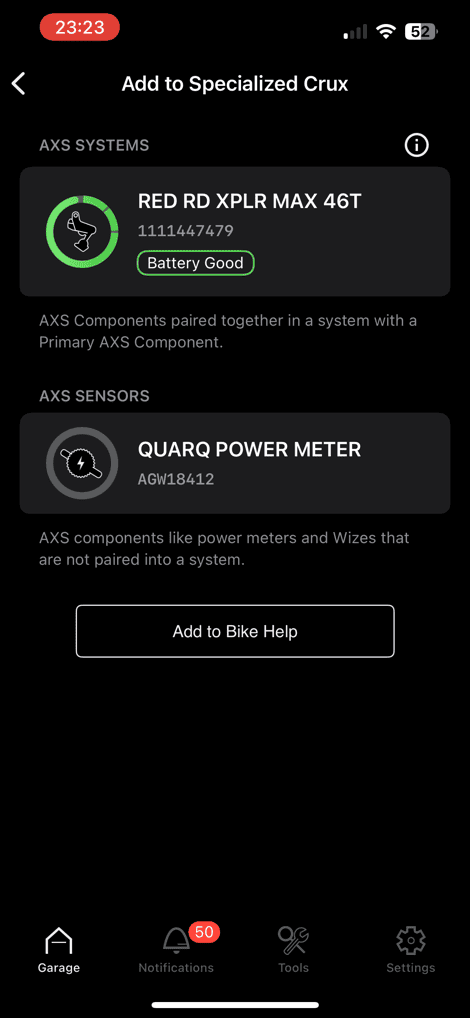
You’ll see the battery status shown for each one. In total, you’re going to have four core comments that’ll show up, in a default configuration:
– Rear Derailleur
– Left shifter
– Right shifter
– Power meter (assuming power meter option)
You could also add SRAM Wireless Blips in there too, if you were to have those. In my setup, I didn’t have any (honestly, I find I rarely use the ones I have had). Either way, it does support them.
If you were to tap any of the shifter or RD components, you’ll see the current firmware, and if there’s anything to update. Updating each of the components took, at most, 30 seconds.



However, if you tap the power meter one, you’ll actually get some legit configuration options for that component, including both a manual torque offset, as well as zero offset, as well as some of the legacy Quarq options that have been around for a decade or so.



Meanwhile, for the shifting configuration, you’ll tap ‘Configure Controls’ and ‘Drivetrain Settings’. For Configure Controls, that’s where you can reassign what happens when you press each shifter individually (or in combination), as well as the bonus button. Given this is a 1x setup (versus a 2x setup), you’re kinda a bit more limited in how many options you have.



By default the bonus button simply duplicates the shifting movement of each left or right shifter (meaning, it shifts). However, you can easily pair that bonus button up to your bike computer. That includes Garmin, Wahoo, and Hammerhead. Simply set Function 1 (above) to be ANT+, and then head to your bike computer.
One thing I *GREATLY* appreciate if using a Hammerhead Karoo, is just how damn smooth they’ve made this integration. I was totally ready to have to scan for all the components and such in the sensors menu, but the moment I powered it on, the Karoo automatically pulled them from SRAM AXS online, and populated my sensors menu – complete with the bike name and all. So good!

Then, I can simply tap the bonus button control in the menu and assign it to one of a gazillion functions, across a slate of categories:

This includes stuff like changing data pages, starting/stopping, setting a lap, and also structured workout controls.
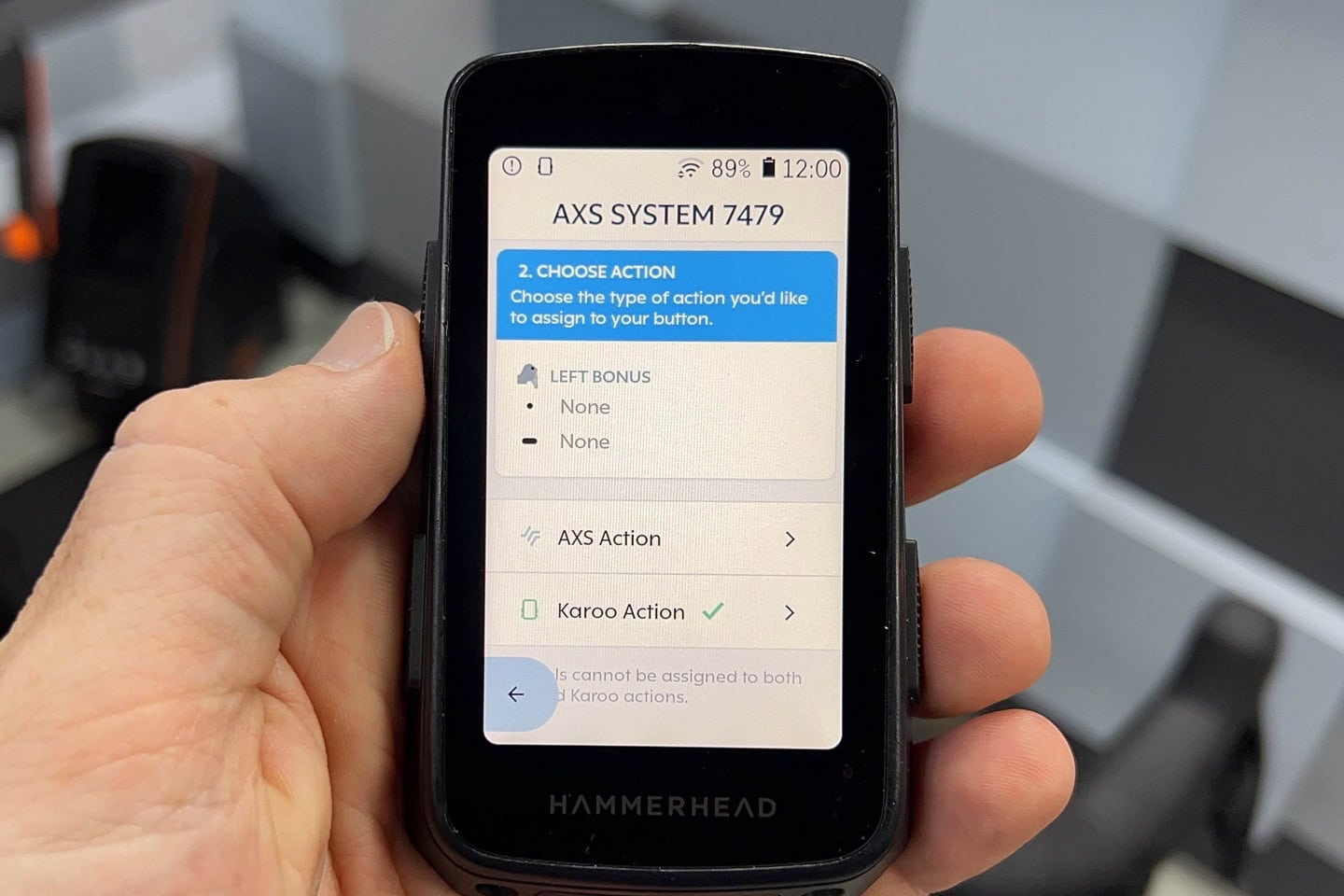
The same concept exists over on the Garmin and Wahoo sides. Here it is paired up to a Garmin Edge 1050, where I’m assigning it to the headliner feature: The bike bell.

So I simply tap the bonus button, and instantly it dings the bike bell. Boom!
Lastly, when it comes to integration with other bike computers, the SRAM AXS systems transmit using the ANT+ Gear Shifting standard. That means that all bike computers support it, and record your shifting data (and battery status) without issue. Nothing proprietary here, nor any vendor lockout (cough…Shimano). You can see this data on various platforms, from SRAM themselves, to Hammerhead’s site, or Garmin (with a Garmin computer), or sites like Di2Stats ironically enough.
Here’s what it looks like on SRAM Web AXS (albeit, at the time of publishing, I couldn’t seem to set up a 13-speed cassette on the Garmin, so the data doesn’t quite translate to SRAM’s site for all cogs):


Ok, with that, let’s dig into the power meter.
SRAM/Quarq Power Meter:

Next up there’s the Quarq power meter, which is branded as a SRAM power meter, given SRAM acquired Quarq ages ago (2011). However, the app still calls it Quarq – so that’s a win for sports tech geeks everywhere.
The groupset can be purchased with or without the power meter option. However, perhaps the most notable thing is that SRAM didn’t force a shift to their controversial integrated chainrings on this power meter. Instead, the chainrings can be easily removed/replaced, and then put back on the power meter (whereas on the SRAM RED Road side, the power meter becomes disposable when the chainrings need replacing, albeit this is after likely 20,000-30,000 miles, and SRAM offers a 50% discount if that happens in the first 5 years).
Either way, none of that matters here, because the two are easily separable from each other.

Meanwhile, the small cap above protects the coin cell battery case, which uses a CR2032 battery. SRAM says the battery should last about 200 hours.
The other big difference between this SRAM RED XPLR groupset, and some of the less expensive XPLR groupsets, is that the SRAM RED XPLR unit captures your total power. It doesn’t technically measure left and right power independently, but rather estimates it based on upstroke/downstroke. Still, the total power is absolutely measured. Whereas for SRAM’s RIVAL-based power meters (including the default units in a FORCE/RIVAL/APEX), those measure only the left-side power via a bottom bracket power meter. They then take that left-side power and double it. With the SRAM RED XPLR unit, it’s instead measuring it via the chainrings, and thus can measure total power from your legs.
The SRAM RED XPLR power meter broadcasts across both ANT+ and Bluetooth Smart as a power signal, this means it’s fully compatible with pretty much every bike computer and watch on the market. During my testing timeframe, I used it on rides with: Hammerhead Karoo 3, Garmin Edge 840, Edge 1050, Edge 1050, COROS Dura, Garmin Epix Pro, Apple Watch Ultra 2, Wahoo ROAM V2, Samsung Galaxy Health App, and undoubtedly more watches and bike computers that I’m forgetting.
Within those ANT+ and Bluetooth signals are the following data metrics:
– Total Power (ANT+ & Bluetooth Smart)
– Power Balance (ANT+ & Bluetooth Smart)
– Cadence (ANT+ & Bluetooth Smart)
– Power Meter Battery Level (ANT+ & Bluetooth Smart)
– Torque Effectiveness (ANT+)
– Pedal Smoothness (Bluetooth Smart)
Technically speaking, it actually transmits torque and calculates watts, but for the purposes of simplicity on your head unit, you’re going to see watts.
To pair it up, depending on your head unit, it’ll either be automatically paired as part of your RED XPLR set (if Hammerhead), or you’ll manually pair it as a new power meter (every other bike computer). In the case of Hammerhead, it’ll show up with the bike computer name (Specialized Crux in my case).

In any event, beyond that, all bike GPS units can easily do a calibration from their respective Zero Offset/Calibration menus. And I had no issues with that, usually completing in a few seconds. You can also do it from the SRAM AXS app, as outlined earlier.
At that point, simply ride like normal, and you’ll see power and cadence shown on your bike computer:
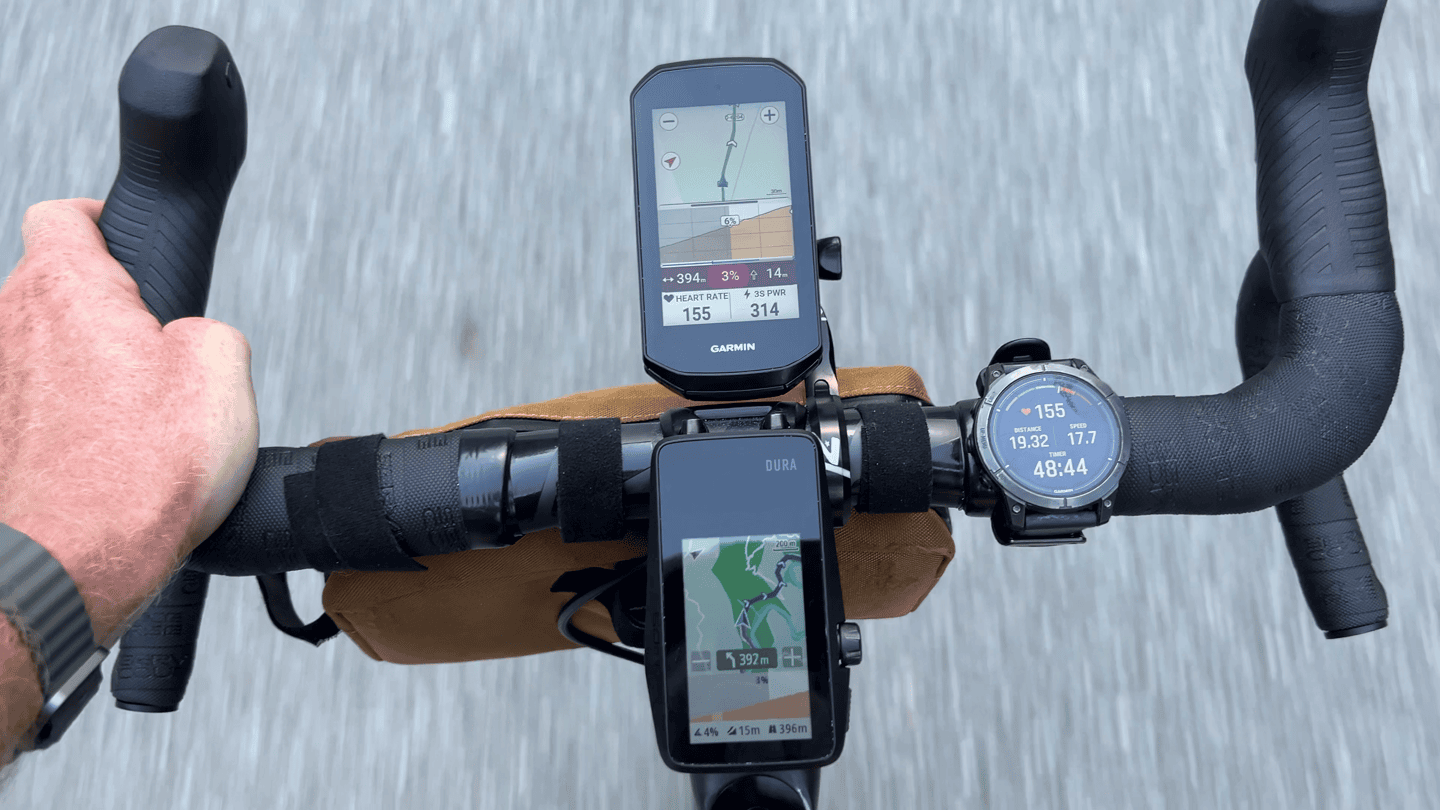
For metrics like normalized power, average power, etc… All these are calculated from your specific bike computer. The SRAM/Quarq unit simply transmits this data over, and your bike computer does the work of figuring all that out.
I’ve gotta say, it’s just so nice riding with a dependable power meter. That might sound silly as a dude whose job it is to test power meters, but there are few power meters out there as effortless as the Quarq units, with a massively high ‘just works’ factor. It’s been that way for nearly two decades, and remains that way today.
Power Meter Accuracy:

Now, despite knowing that the power meter should be accurate, that doesn’t mean I’ll believe it. As always, testing needs to occur, and validation needs to happen. That’s what this section is all about.
I’ll try and keep things efficient here, for all of our sakes.
Before I go outside and do testing, I usually do some quick indoor trainer testing to see how things handle on known-good trainers. Usually if things can’t pass the test inside, they certainly won’t do so outside with vibrations/terrain, temperature, humidity, weather, etc…
In this case, SRAM didn’t have a spare 13-speed cassette, so I ended up just doing a test in ERG mode on the Tacx NEO 3M with a 12-speed road cassette. That’s not quite perfect in terms of testing, because the chainline wouldn’t have been super efficient. But, I also had the Favero Assioma Pro MX-2 on there as well, so I was really looking to ensure that relationship was good, and if the Tacx NEO 3M was a bit lower due to more drivetrain losses, that’d be fine.
Here’s that data set:

And indeed, exactly as expected. The Favor and Quarq are often within 1-2 watts, perfectly aligned, while the Tacx NEO 3M is a bit lower, given the non-optimal cassette configuration. Again, there’s nothing wrong with the NEO 3M (it’s arguably the most accurate smart trainer in the world right now), it’s simple drivetrain losses getting to it.
So, outside I went, this time for a quick validation loop around the forest. The results of this are pretty astonishingly similar (to the Favero Assioma Pro MX-2), even cases at 750w, and they’re only 10w different – which is super impressive. One might be mistaken thinking this was simply one power meter paired to two different head units. But no, it’s two different units from two different companies.

At this point, you can guess how this is going to go, right?
Let’s just skip ahead to some spicy stuff, and skip a month of more general rides. Instead, here’s a sunset ride from the sea up nearly 9,00m (3,000ft) into the mountains. This is most notable because I started just before sunset, and would ride 2.5hrs into darkness. Thus, the temps would shift dramatically (due to both sunset and climbing into the mountains). Yet, the power meters stayed perfectly glued together. Here’s a snippet at the beginning:

One in the middle:

And one towards the end:

Cadence was also spot-on:

As was the mean-max graph:

The next day, I continued climbing, this time transitioning from road to gravel, for 8.5 hours of riding (and…some non-riding). Again, over the course of the day, including as darkness set and temps shifted all day long from hot AF to chill, the unit stayed perfectly aligned. Here’s a couple snippets. First, an earlier climb:
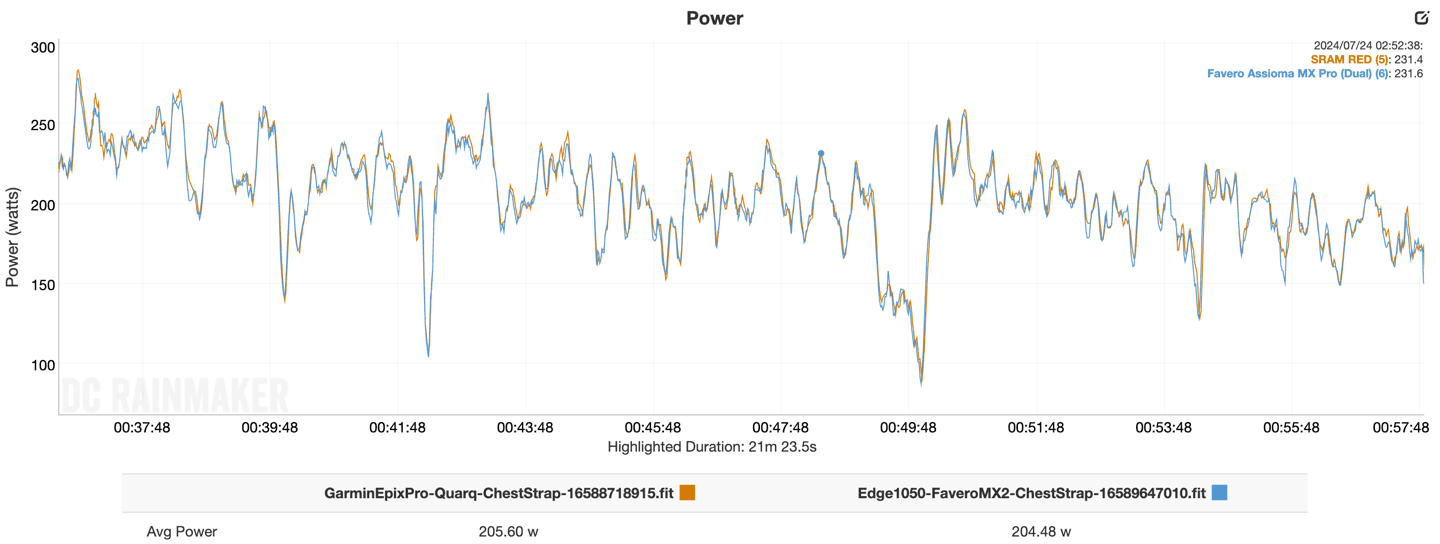
Same goes for cadence:

Then some mid-day climbs. Even here, on rougher gravel, we only see a few watts of expansion between them (which is what I typically see as conditions get rougher, companies vary slightly on the algorithms to deal with the noise).

Again, very solid, spot on.
I’ll save you the same charts during the descent, because they’re kinda a bit messy to look at, since power is up/down a bunch.
So instead, another ride just for fun, tossed in, to show how close these two units were. Here’s one short snippet from that ride, as I stupidly only brought with me one Garmin on that ride, and had depended on the COROS Dura for power meter data, which was mostly OK, except when I stopped and got sticky watts. But, here’s a ‘clean’ section for random browsing.

Ultimately, as one would expect, you’ve got two hyper-accurate power meters, that seem made for each other. The numbers stayed glued together, and I didn’t have to do any special dances to get them to stay happy either. It’s my kind of testing.
(Note: All of the charts in these accuracy sections were created using the DCR Analyzer tool. It allows you to compare power meters/trainers, heart rate, cadence, speed/pace, GPS tracks, and plenty more. You can use it as well, more details here.)
Zipp 303 XPLR Wheelset:

Lastly, I want to briefly touch on the Zipp 303 XPLR wheelset. This new wheelset from Zipp is designed to be the pinnacle of gravel wheels in terms of performance, when paired with one of the three approved tires. And specifically, even more so, when paired with Zipp’s own new XPLR tire made in partnership with Goodyear.
That tire comes in a few different sizes (see the specs way up high in the post), but in my case I was running it with the new 45mm XPLR tires. Yes, 45mm. It’s massive.

Now, the main justification with a wheelset and tire combination like this is that you can run substantially lower pressures, which increases performance, while being designed to be the fastest possible tire from a speed standpoint (including factors like aerodynamics with the Zipp 303, and rolling resistance with the tire). In their media presentation (linked above), SRAM talked quite a bit about how the speeds at events like Unbound continue to get faster and faster each year, ultimately requiring a tire like this to be built.
In riding it over the last month, it’s really unlike any other gravel tire I’ve ridden. Effectively, it feels like running a mountain bike tire. Mentally, you think about your performance and handling abilities very much like a mountain bike tire, except, you just go a heck of a lot faster in other conditions. It continues to be mentally counterintuitive that lower tire pressures are faster, but that debate has long been settled by science and testing over the past few years. Hence why people on road bikes are no longer running tires at 110psi or above.

Now, while I loved almost all of my time with this wheelset combination, it can’t be left unsaid that things didn’t end well. Specifically, deep into the mountains, well out of cell phone coverage as I was working my way to the refuge for the night, I got a double-puncture on the sidewall. This was while pedaling on very chill and very tame gravel:

It roughly looks like a pinch flat, but as luck would have it, I actually was recording from a drone at the time, and have the whole thing on video (see the video at the top of this post, and the Zipp section/chapters). It appears that the wheel/tire sidewall somehow struck the side of a rock, and it either caused a pinch flat, or a double-puncture. It’s hard to know exactly. Either way, I had two big holes that needed plugs.

Unfortunately, the plugs wouldn’t hold more than a minute or two before failing. Even some off-road motorcyclists that were touring had bigger plugs, and those wouldn’t hold pressure either.

Naturally, I shifted to grabbing the spare tube. Except…umm…the spare tube I had in my bag was…umm…not with long enough valve stems. Well then, crap. My bad.
So, a few hours of walking and such ensued until I got to the refuge. We tried to patch it there, but the patch wouldn’t hold well, due to needing overlapping patches on two sorta-close punctures. Or, maybe it was something else. Either way, air wasn’t holding long term.

Luckily, in a random bookshelf at the refuge, they had 9 tubes. Of which, precisely 1 of them had long enough value stems. I stuck that in there, and managed to descend the 90km back to the ocean the next day. Woot!

However, upon getting to the ocean, I noticed a new fracture on the sidewall on the complete opposite side, which, seems…non-ideal.

At this point I bundled all this stuff and sent it to SRAM, including the exact tire pressures I was running (via the Quarq TyreWiz I had installed). I had set it to precisely the pressures SRAM had sent over as recommended for my weight combination.
To SRAM’s credit, after reviewing all the footage, details, pressures, etc…, they agree the terrain in this area shouldn’t have caused this outcome. I’m getting the tire back to them, and they’re working with Goodyear to figure out what’s gone wrong.
Thus at this point it’s hard to know what the source of the issue is. On one hand, punctures can happen. That’s part of cycling. However, this wheel+tire’s entire point in life, priced at over $2,200 is to not puncture on this (and much more challenging) terrain. Given this wheel is only approved for three different tires, and this is SRAM’s premier pick, it’s a bit of a disappointment.
Hopefully, though, this was just a typical DC Rainmaker one-off of bad luck. Perhaps I was just the dumb unlucky dude who manages to double (or triple) puncture a tire. I suppose only time (and details from Goodyear) will tell. On the bright side, it was an awesome tire till that point. Also, next time I’ll ensure I double-check my spare tube valves before I go into the wilderness. And of course, thanks to the crew and others at the refuge as we spent the evening trying to salvage it.
Wrap-Up:

Looking at the SRAM RED XPLR groupset, it’s pretty clear they’ve established a new benchmark for a gravel groupset. Be it from a durability or performance standpoint, it’s pretty hard to beat. On the shifting side, you’ve got the components people know and love from the SRAM RED road lineup, while in the rear you’ve got effectively SRAM Transmission from the MTB side. And in the middle, you’ve got a full Quarq power meter that’s known and trusted.
There’s frankly very little to complain about here, except for the usual: Price.
As always, we’ll have to see what the end-state pricing looks like on bikes over the coming hours and days, since that’s the price most consumers will actually pay. That said, I’d expect it’s going to be relatively similar to the pricing with existing SRAM RED XPLR (previous gen) on it. After all, the bike industry certainly isn’t in a position right now to get all crazy with prices, given the glut of inventory that many manufacturers still have.
Still, despite all that, at the extreme other end of the SRAM spectrum is the SRAM XPLR Apex AXS groupset launched last summer, that’s still an incredible bargain, and a joy to ride. Thus, options abound.
With that – thanks for reading!
FOUND THIS POST USEFUL? SUPPORT THE SITE!
Hopefully, you found this post useful. The website is really a labor of love, so please consider becoming a DC RAINMAKER Supporter. This gets you an ad-free experience, and access to our (mostly) bi-monthly behind-the-scenes video series of “Shed Talkin’”.
Support DCRainMaker - Shop on Amazon
Otherwise, perhaps consider using the below link if shopping on Amazon. As an Amazon Associate, I earn from qualifying purchases. It doesn’t cost you anything extra, but your purchases help support this website a lot. It could simply be buying toilet paper, or this pizza oven we use and love.


















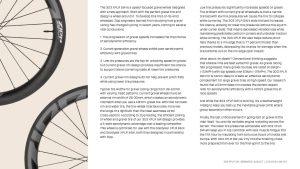



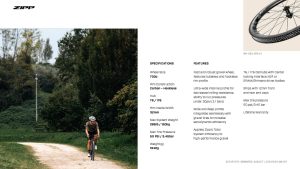































It would appear that you’re not the only tester having problems with that wheel set up.
Off topic, but thanks for making me go out and check that the valve stem of my emergency tube is long enough for my Zipp 303 S’s – it isn’t.
Great Review – but also a great plug as to why to carry a small satellite messenger. “Dear wife, I am ok, but bike broke, please come get me”. Also, practice this before it is really needed.
Always worth it o carry one of these in addition to a spare tube.
You may never need it until you do.
So, with the direct mount rear mech, going into the spot normally occupied by a UDH, eliminating the B-screw, doesn’t that make this mech completely incompatible with potentially other cassettes?
Great review thanks Ray.
Slight tangent but the HH Karoo 3 has a bell function too! You get the option to use it if you pair blips to it (which I did today)… works ok, might as well use that turbo-loud beeper for something useful ;)
Any comments on limited (non-existent) cassette choices and the price? I’ve seen $600 mentioned elsewhere.
Only one on offer so far is the 10-46 I think.
Hi Ray,
do you need to do any extra configuration to make AXS write data into fit files? Granted, I have an older groupset (first-gen AXS Force), but I’ve never seen any shifting data written into the file – not without some extra ConnectIQ datafields.
It would have been nice for Sram to create a stem mount base with the karoo proprietary adapter like k-edge did. The HMS system is great but so few options to have it installed centrally on a cockpit.
Not sure if it’s an oversight or a protest but I just realised you still have Twitter logos in various places on the site Ray :) This includes on the home page and the share bar at the bottom of the posts
Is there any way to shift the derailleur from either the AXS phone app, or from a bike computer screen, in the event the shifter head battery dies?
I know you can get off the bike and manually shift, from the derailleur side button (single tap up-shift, double-tap down, i believe), so you’re not completely stuck with a single gear for that scenario.
Just wondering if there’s a way (or at least thoughts that SRAM is working on it) to have some redundancy to the shifter levers?
I know that back-up coin cell batteries, or a back-up specific blip could help, as well.
I’ve been using AXS for a couple of years now, and have had a few failures of near-full charge batteries, particularly when riding in fairly extreme cold.
The shift lever batteries have acted up more in that regard, than the derailleur battery; not sure why.
the most badass move from sram would be to bring out a 10-52, 13 speed cassette and make 13 speed available for all Eagle Transmission mtb derailleurs with a firmware update and a new version of the axs app. everyone would loose their mind. since they are using udh, 12 speed chains and xdr didn’t change either, I don’t see any blockers that would prevent them from doing this. and it would benefit mtb and gravel riders alike.
otherwise, having a separate XPLR groupset is dumb in my opinion. 10-46 it is great for a pro racer, but an average human being, especially someone who wants to go bikepacking offroad, would greatly benefit from a wider cassette. and, since gravel bikes can accommodate wider tires, people can go more into mtb territory, so they need the wider range even more. but right now, sram can’t have a 10-52 cassette for a 13 speed xplr (which they have for apex, lol), because that would make all the transmission derailleurs obsolete in an instant on the mtb side.
… or they can just release a new 13 speed transmission groupo, so they can sell more stuff, of course :D
I’d love to know why there are only three approved tires. Is this just a pendulum swing reaction to road hookless blowouts with people using known bad setups and blaming the rims, or is there a legitimate bead difference on these approved tires?
The recent ISO TSS(hookless) standard calls for a tire width of at least 58mm for a rim this wide. Zipp is testing and approving individual tire models that are narrower than that as safe to use with this rim in order to maximize the aero gains.
A nice group set BUT, I rode well over 50K km with a Rohloff and a few carbon drive belts throughout Europe. And I have never understood why a Rohloff is not more popular compared to a 12 or 13 speed systems. The chain-line isn’t ideal anymore, the chain is narrowed (compared to single speed or IGH), the efficiency is not substantial better as the chain is never clean (try cycling off-road in the rain), and cost is also not issue as this group set is almost twice that of a Rohloff and will wear at lot faster. Or, the worse shimano alfine 11 has been used by specialized AWOL gravel bike packing bike for long time.
Step 1 would be for Rohloff to make modern drop bar shifters. Gebla box is not going to fly for a variety of reasons.
Even after that the weight/price/efficiency arguments aren’t nearly as clearcut as you’re making them out to be.
The market has rusted into derailleur systems that are not so durable on the long term. Unfortunately no one ever decided to make a drop bar shifter for a Rohloff. Though the Alfine 11 can be used with a drop bar shifter. And why it must always be a drop bar steerer? I have used various group sets from cheap 105 and Duore to dura ace and xtr and xtr-rc and ALL of them did not outlast 20k km without major component replacement e.g. the derailleur itself. But apparently the world around is covered with people who prefer to boast how expensive their bike is instead of actually using them in ANY condition.
Hey, I was able to find a drop bar setup on Rohloff’s website here: link to rohloff.de
Any word on when and if 13sp explr will be released as a force or rival groupset?
Undoubtedly over time it will, but I’d expect that to happen on the usual cascading schedule. In other words, probably a year out for force, then eventually rival, etc…
If the power meter has Magic Zero, why do you need to do a Zero Offset Calibration?
It’s a good question, and I think in general, you don’t need to manually do one. However, most of these auto-zero type scenarios can sometimes have a delay when there’s a massive shift in temp from the previous zero, such as when you go from inside to outside, or such. That’ll normally work itself out within 10-15 mins, but this allows you to basically tell the power meter “hey, I’m manually zeroing you, because I know this is good”, versus it taking those samples over time and being like “ok, after 10 mins of samples at this temp/force, I believe you”.
Further, there are some edge cases where you might want to turn Magic Zero off, if it’s giving incorrect corrections. I actually ran into some of those in June on the new SRAM RED power meter (post-review), that I’m working with SRAM to troubleshoot over the past few weeks. These would cause brief 20-30 second substantial power inaccuracy issues (50% of actual wattage). I haven’t seen them appear on RED XPLR, nor had I seen them appear prior to June. So…yeah, still digging into what’s causing that. But point being, SRAM has confirmed Magic Zero is causing it, but we haven’t figured out yet why it’s going wonk. So, that’s a scenario where turning it off would resolve that.
Thank you very much!
If you went with a SRAM Force XPLR set up you’d be ditching your chainrings and power meter compared to the Red XPLR? Just want to be completely sure and informed while shopping.
No, Force XPLR uses the power meter insert thingy, so it’s basically a left-only setup. Different than SRAM RED road.
Thanks. I didn’t do a great job asking my question.. hah
I meant if you needed to swap or replace a chainring while running Force XPLR, you’re on the hook for the a new power meter because you have to swap the whole thing versus Red XPLR?
That photo of the hairpin bend in the fog I would say is the Alta via del sale in the Cuneo Alps–my backyard :) Will you tell us about it in a post or video?
That Specialized bike with this Explr group set is $16K Cdn: Ouch!
I have the new SRAM RED XPLR AXS group set with the Power Meter on my Trek Checkmate SLR 9. I notice in the Garmin Connect website and app that for any given activity the Left/Right balance is always 56%/44%. With my dual sided Garmin Rally pedals the Left/Right balance is always with in 1-2%. So I wonder if there is a bug with the Garmin Edge (840) not to properly record the SRAM power meter data.
I just looked for my ride yesterday from XPLR AXS, and it’s showing 52/48.
Keep in mind that the SRAM left/right balance isn’t technically left/right balance. Rather, it’s actually the front/back portions of the stroke, which Quarq/SRAM attempts to assign to left/right. Said differently, it’s a different metric under the covers, but back when it was added 15 years ago, left/right balance was the only data field available, so that’s where it ended up.
Any update from SRAM / Goodyear on your issues? Seems to be a few reviewers and buyers struggling with flats and hard to know if holding fired best course for now!
On 3 rides with my new Zipp XPLR S, I had 2 punctures at the sidewall (one single hole, one double). One was a race, 200 meter to the finish line, costing me quite a few places. On all rides I put in the pressure recommend by Zipp by their online calculator. I’m using the Slick version of the tire, that seems to be very, very fast, compared fx to a Pathfinder 38mm, what usually is my go to tire choice. So I was hoping, the Inter gave other results, but that obviously isn’t the case.
I’m quite disappointed and curious, how Zipp is going to handle the problem.
Bummer. :(
Fwiw, I have another bike, this one equipped with the Slick version of these tires. I’ve put a fair number of gravel adventures on this one now, without any punctures, including much rougher/sharper terrain than the Inter’s I was running on the other bike. Zero punctures (or at least, any punctures I’ve seen, perhaps sealant grabbed others).
Of course, the downside is that the Slick is very much not the same as the Inter. I really liked the feel of the Inter. I’ve also been running the Slick a tiny bit higher on the tire pressure side, which again both helps resistance, but inversely hurts ride feel.
I don’t have any information from Zipp in terms of next steps at this point, other than they continue to investigate. Meanwhile, I bought another pair of Inter’s (since the first one was trashed), that at some point on a bored day I’ll switch over to, and see if it’ll last.
“…a tiny bit higher” means what? I’m trying the approach to run with 40 psi instead of the recommended 32. Then I will try to reduce the pressure again until I feel the rear wheel begins to hit the rocks again. There must be a sweet spot somewhere…
I’ve been around 34-36psi. Sometimes a bit higher as well, depending on the exact rock type.
Power Meter Question. I ride with a Garmin 1040 Edge paired with a Garmin Forerunner 965. I have a cadence monitor on my cranks. No Power Meter. Somehow, someway, my 965 delivers an FTP calculation at the end of my rides. Are the numbers trustworthy?
Thanks for a great review as always!
Any hints or past indications of when we can expect Force and Rival groups following XPLR design?
I mostly mean new hoods design and the robust UDH derailleur, 12s is already plenty, but the new shifters/hoods feel so much better than the old ones…
Great review! Thanks! If you were building up an All-road/gravel bike – one to do it all (terrain covered by 33mm – 42mm tires, say) would you put SRAM Red XPLR or the SRAM Red Road groupset on it?
Assuming $ wasn’t a factor, I’d probably put RED XPLR on it. I’ve got it now on my Canyon Gravel bike, and it’s just nice not really having to worry about anything with the RD while travelling. It’s a tank.
The downsides of course are price, especially for an extra cassette for trainers, super pricey. And then if you go with that Zipp wheelset, all of the flat issues widely reported by almost every review out there. Though, FWIW, I’ve managed to avoid any further flats, and have been riding it on terrain that is frankly more MTB than gravel the last 6 months (moved to Mallorca in Sept), and all my off-road riding has been on this bike, with pretty chunky/spicy gravel routes that have lots of sharp rocks, really just rocks, and haven’t flatted once. Though, I’ve been running higher pressures than SRAM’s calculator recommends, which is probably why I haven’t flatted (but equally, it’s not as smooth of a ride).
I have to ask, is that with the goodyear inter still (just with higher pressures) or change of tyre over those 6 months?
G4-x finally (7 months after ordering) at LBS and wheel choice is upon me. Road wheelset 303s so Xplr S may make sense with same hub/alignment etc but UK riding not blessed with champagne gravel!
Ahh yes, that’s a good point.
So the bike came with Goodyear Slick’s instead (versus the Inter’s in this review). So I’ve been using that. I bought a pair of Inter’s to put on it, given the terrain, and figured I’d just swap them out when the Slick’s died (which I presumed they’d puncture months ago). For better or worse, that hasn’t happened yet, thus, I’ve been too lazy to swap back.
Thank you. I’m very impressed by the 13sp. I was wondering, do you think the gear ratios suffice as a road bike?
For me, it’s worked pretty well on the road. I’ve done a fair bit of road riding with it, where my wife will be on her road bike, and I’ll be on the gravel bike. I usually add a bit more air to even things out. But from a gear ratio standpoint it’s not been a problem.
Sorry – I’m not being very specific. Lacking coffee this morning! I’m building up a titanium AR bike, and I’m considering 2 wheelsets. I have an Enve g23 set, and considering buying an Enve 3.4 set too. Effectively having one bike with two wheelsets for gravel and for road. The bike will take 42mm tires – which covers everything I like to ride. I’m really wondering if the gear ratios feel hard enough for flatish road/gravel riding in the winter, then into the mountains in the summer (Living in Boulder). My current road bike has 460% with 1×1 ratio on the climbing end of the gears – a little too hard for an all day ride. So if you put a 42 chainring on the front of the new XPLR, that gives a a nice climbing gear, but leaves you with 420% at the other end. Maybe 2 wheel sets and and two chainrings?
Enjoying your reviews VERY MUCH!